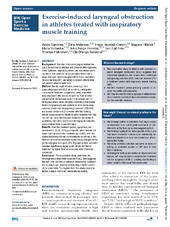Exercise-induced laryngeal obstruction in athletes treated with inspiratory muscle training
Sandnes, Astrid; Andersen, Tiina Maarit; Clemm, Hege Synnøve Havstad; Hilland, Magnus; Vollsæter, Maria; Heimdal, John-Helge; Eide, Geir Egil; Halvorsen, Thomas; Røksund, Ola Drange
Peer reviewed, Journal article
Published version

Åpne
Permanent lenke
https://hdl.handle.net/1956/20694Utgivelsesdato
2019-01-18Metadata
Vis full innførselSamlinger
Originalversjon
BMJ Open sport & exercise medicine. 2019, 5 (1), e000436. https://doi.org/10.1136/bmjsem-2018-000436Sammendrag
Background Exercise-induced laryngeal obstruction (EILO) is common in athletes and presents with dyspnoea, chest tightness, inspiratory stridor and sometimes panic reactions. The evidence for conservative treatment is weak, but case reports suggest effects from inspiratory muscle training (IMT). We aimed to explore effects from IMT used in athletes with EILO. Method Twenty-eight athletes, mean age 16.4 years, diagnosed with EILO at our clinic, participated in a 6-week treatment programme, using a resistive flow-dependent IMT device (Respifit S). Four athletes competed at international level, 13 at national and 11 at regional levels. Video-recorded continuous transnasal flexible laryngoscopy was performed from rest to peak exercise (continuous laryngoscopy exercise (CLE) test) and scored before and 2–4 weeks after the training period. Ergospirometric variables were obtained from this CLE set-up. Lung function was measured according to guidelines. Symptom scores and demographic variables were obtained from a questionnaire. Results After the treatment period, symptoms had decreased in 22/28 (79%) participants. Mean overall CLE score had improved after treatment (p<0.001), with the scores becoming normal in five athletes but worse in two. Most of the improvement was explained by changes at the glottic laryngeal level (p=0.009). Ergospirometric variables revealed significantly higher peak minute ventilation explained by higher tidal volumes and were otherwise unchanged. Conclusion This explorative study underlines the heterogeneous treatment response of EILO and suggests that IMT may become an efficient conservative treatment tool in subgroups, possibly contributing to better control of the vocal folds. The signals from this study should be tested in future controlled interventional studies.
